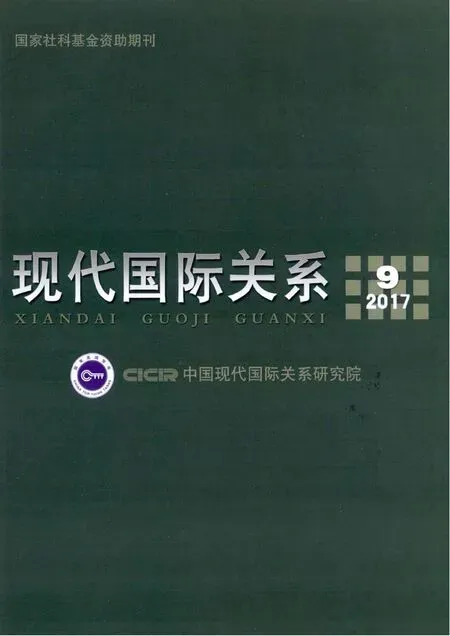Abstracts
2017-11-24
s
RiseofChinaandtheStructureandOrderinEastAsia:StatusquoandtheFuture
HanZhaoying&HuangZhaolong
Abstract: The rise of China and the structure and the order of East Asia has always been an important topic of concern. The rise of China has led to the change of structure of power in East Asia, and it has also brought about the change of the order in East Asia. This article first discusses the definition and connotation of the rise of China and on the basis of the related facts our analysis found that the rise of China as a Great power in international system has been exaggerated, the process of the rise has just begun, and only part of the rise of economy. Then, the article analyzes and predicts the East Asian structure of power in the present and future nearly 20 years, and the finding shows that a bipolar structure of China and the United States has emerged in East Asia, and will continue to evolve towards this structure within the next 20 years. Finally, this article argues that the future of the regional order in East Asia will depend directly on the Sino-US strategic interaction. In the conclusion, we propose “The one-fastness-and-one-slowness strategy, and the Double-headed leadership” as the direction and path for the future of the regional order in East Asia.
Rise of China; East Asia Power Structure; East Asia Regional Order
“ThucydidesTrap”:MisunderstandingsandRespondingStrategy
LiHaibo&SongRuizhi
Abstract: From the theoretical point of view, “Thucydides trap” belongs to realism theory. From the perspective of political strategy to return to the historical starting point of Thucydides trap, this theory proposed by Graham Allison and other western scholars has three main misunderstandings about the relationship between Athens and Sparta and China-U.S. relationship: the theory of power determinism, the theory of war benefit and the theory of bilateral relations. The three misunderstandings were involved in the objective and subjective factors, and the category of factors of Thucydides trap. In this regard, China should avoid the trap of theory of power determinism, grasp the strategic initiative; adhere to the strategy of reform and opening to the outside world to promote sustainable development and rise;construct the peripheral community of common destiny, manage and control third party factors in bilateral relations between China and the United States constructively.
Keywords:Thucydides trap, power, political strategy, reform, third party factors
Israel’simageinUSandChineseMedia:DiscrepanciesandCauses
NiuXinchun
Abstract: In Chinese media, Israel’s image is basically positive and vigorous with focuses on Israeli economy, history, culture, science and technology, and China-Israel cooperation. A culture-rich Israel with tough ethnic nature, powerful science and technology is unveiled before the audience. On the contrary, in US media, Israel’s image is always negative and struggling, with focuses on Israel’s internal political struggle, fragmentation of society, racial discrimination, Israel-Palestine conflict, and deterioration in foreign relations. An internationally-isolated Israel with political polarization, divided society, ethnic separation is displayed before the audience. The inclinations of news report in China and the US are closely related, and disconnected, with the public opinion and government policy in their own country. It is like the blind men trying to size up the elephant—take a part for the whole, or even choose facts from a specific point of view.
Keywords: Palestine-Israel Issue, China’s Foreign Policy, US Foreign Policy, Israle
NewTrendofJapan-USeconomicCooperationandItsProspect
ChenYoujun
Abstract: The Trump administration pursues the “US first” economic policy and attacked Japan on the trade issues. Under the Trump administration’s pressure, Japan actually strengthened its economic cooperation with US, in order to stimulate US’s economic growth. However, Japan is still worried about the prospects of Japan-US economic cooperation, the Trump administration’s “economic unilateralism” and its economic policy feasibility, and Japan’s overseas interests and other problems. Accordingly, Japan-US economic cooperation relations will appear the development mode of “double speed type”. That is, energy and agricultural trade and other tactical issues will be a breakthrough, but the US-Japan FTA, TPP and other strategic issues will be protracted.
KeyWords: Japan-US relations; Japan-US Economic Cooperation; Japan-U.S. FTA; Economic unilateralism;
FactionalStruggleswithinOPEC:Causes,ImpactsandTrends
ChenTenghan
Abstract: Factional struggles between the hawks and doves within OPEC have been going on for a long time. There are many factors contributing to the struggle. Internal causes comprise differences of basic national conditions and organizational defects of OPEC itself. Meanwhile, external causes include changes in international oil markets and diplomatic relationsamong OPEC member nations. Overall, factional struggle swithin OPEC have great impacts on international energy markets, oil exporters, OPEC itself, the situation in the Middle East and energy geopolitics. From the perspective of current relations between the hawks and doves, there are three possibilities in the future of factional struggles within OPEC: to ease, to maintain the status quo and to break down.
Keywords: OPEC; factional struggles; causes; impacts; trends
(Edited By Zhao Jinfu)
